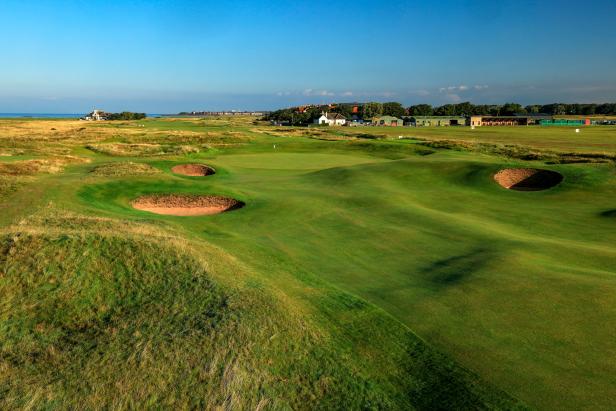


You know it as the long wispy grass that grabs your club and forces you to thoroughly check for ticks, but fescue grass is much more than agonizing long stuff. Cut at shorter lengths, fine fescue characterizes the rough, fairways and greens of many links courses and helps deliver the bouncy conditions that are deemed ideal in the British Isles.
The use of fescue grass can be polarizing among superintendents. Many top courses—like Bandon Dunes, Whistling Straits and Sand Valley—use fescue extensively, while others, notably Erin Hills and Chambers Bay, have moved away from it in recent years.
To better understand the benefits of fescue grass, its limitations and why it might be the most eco-friendly option available, we caught up with Michael Galvin, the director of agronomy at The International in Bolton, Mass. Galvin is currently overseeing the grow-in of fescue grass on the club’s new Bill Coore and Ben Crenshaw-designed Pines course, which when completed will be one of a few New England courses to use fescue.
Golf Digest: Michael, what are some of the appeals of fescue grass?
Galvin: Fescue is deeply tied to the heritage and tradition of golf. I worked at East Hampton Golf Club, another Coore and Crenshaw design on the eastern end of Long Island, and it took me a little while to figure out that I was looking at the same thing—the fescue grass was the same in the fairways, in the rough, and in the far native rough. Your eye is looking at the same grass, just a different heights.
That is really the visual appeal of it—how it transitions to natural environments. With bentgrass, bluegrass and ryegrass, it doesn’t flow the same way that fescue does. Fescue also does a great job of highlighting the topography—the fine texture and muted color accentuates the natural contours and undulations of the land, making the course more visually prominent and engaging.
There’s also a lot more tolerance to drought and shade with fescue. It’s definitely more adaptable than other types of grasses.
As a superintendent, do you maintain fescue differently than other types of grasses?
Galvin: Yes, and that’s part of the benefit of it. You can certainly reduce all your inputs. Fescue has low nutrient requirements, and it thrives on less fertile soils. That reduces the need for frequent fertilization and means we can water it less than other types of grasses.
Like I said, it’s highly drought tolerant, which is advantageous for water conservation and maintaining that firm playing condition. Fescue is drought resistant because it has deeper roots than other types of grasses, which is really beneficial. It also has a slower growth rate than bentgrass, which helps reduce mowing frequency as well.
So with fescue, we use less chemicals, pesticides and water, which is why it promotes more sustainable and eco-friendly golf course management practices.
How does fescue play for golfers compared to other types of grasses?
Galvin: The fescue has an upright growth habit, which almost makes balls seem like they are on a tee. The ball sits right on top of the grass. Whereas with bentgrass, it’s creeping, so the grass grows along the dirt. The ball doesn’t sit up as much. The fescue is more tightly bunched and dense, making the ball sit right up.
Fescue also has a tendency to be a little firmer than other grass types. That keeps the fairways crisp and well defined.
Some courses have moved away from fescue. Are there any limitations to it?
Galvin: Yeah, fescue needs to be on sandy soil. It definitely doesn’t like wet feet. There has to be sandy, free draining soil for it to work. Luckily for us in Bolton, Mass., we have a nice pocket of glacial outwash that has sandy soil, so we can pull off the fescue grass.
At the same time, fescue is really adaptable. It can adapt from full sun to deep shade, making it pretty versatile for a golf course. The key, though, is to have sandy soil.